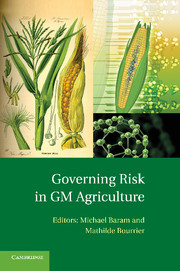Book contents
- Frontmatter
- Contents
- Preface
- Contributors
- 1 Governing Risk in GM Agriculture
- Part I Risk Governance and Public Discourse
- Part II Future Challenges
- 6 Coexistence and Traceability of GMOs in the Agro-Food Sector
- 7 The “Pharming” Challenge
- 8 GMO as a Sustainability Issue
- 9 Applying Safety Science to Genetically Modified Agriculture
- Index
- References
9 - Applying Safety Science to Genetically Modified Agriculture
Published online by Cambridge University Press: 01 March 2011
- Frontmatter
- Contents
- Preface
- Contributors
- 1 Governing Risk in GM Agriculture
- Part I Risk Governance and Public Discourse
- Part II Future Challenges
- 6 Coexistence and Traceability of GMOs in the Agro-Food Sector
- 7 The “Pharming” Challenge
- 8 GMO as a Sustainability Issue
- 9 Applying Safety Science to Genetically Modified Agriculture
- Index
- References
Summary
Introduction
Our main goal in this chapter is to determine whether decades of work in safety science and safety management have value for resolving controversies about GM agriculture. The implicit hypothesis is that there may be some commonalities between the safety issues posed by GM agriculture and other risky technologies, and potential benefits from using the toolbox of safety science that has been developed for more than thirty years in these other technological sectors. To avoid any misunderstanding, the discussion and points raised in this chapter do not cover the totality of the issues posed by genetic engineering. Our objective is to apply the safety science toolbox to the sharp end of the industry, that is, the crop growing practices on farmland.
Historically, safety science has dealt with high-risk technological enterprises (nuclear power industry, chemical industry, aviation industry) and more recently with medical practices (Vincent & De Mol, 2000; Amalberti, Auroy, & Berwick, 2005). Safety science has expanded over the years. It consists of research blending several disciplines, notably ergonomics, engineering, design, occupational health, sociology, or environmental studies. Issues like human and organizational failures, contributing factors to error production, implementation of risk/hazard mitigation strategies (such as risk analysis and modeling, event analysis, systematic incident reporting system, or safety culture and management surveys) are recurrent topics in safety science (Hale, 2006). Thus, another goal of this chapter is to further extend the reach of safety science to GM farming.
- Type
- Chapter
- Information
- Governing Risk in GM Agriculture , pp. 235 - 267Publisher: Cambridge University PressPrint publication year: 2010



